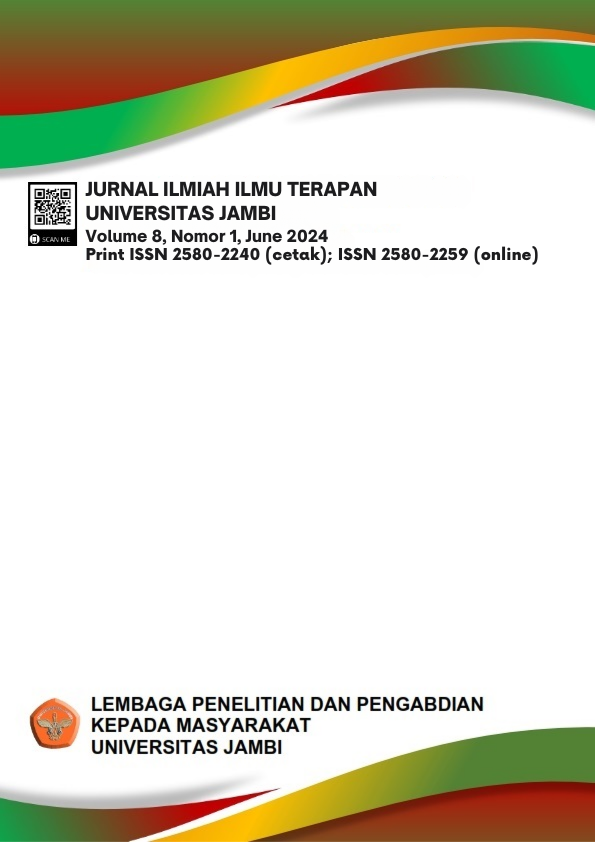BREADFRUIT PEEL AS THE MOST POTENT RADICAL SCAVENGERS FOR SKIN PROTECTION
DOI:
https://doi.org/10.22437/jiituj.v8i1.33966Keywords:
ABTS, Artocarpus Altilis, BSLT, Lotion, Scavenging, SPFAbstract
The sun's ultraviolet radiation causes erythema, premature aging, sunburn, hyperpigmentation, inflammation, and dry skin. For this purpose, sunscreen with an SPF value of over 15 is needed to protect the skin against UV rays. Breadfruit peel containing flavonoids may protect against free radicals and UV radiation. This study aims to increase SPF value from breadfruit fractionate by combining niacinamide and alpha-tocopherol. The ABTS and BSLT methods were used to screen potent free radical scavengers in n-hexane, dichloromethane, ethyl acetate, and methanol extracts. The dichloromethane extract had the highest potential as a free radical scavenger, with IC50 20,90 more or less 0,54, and the lowest toxicity, with LC50 234,42 more or less 1,06. Then, the scavenging activities and selective index of fractionates of dichloromethane were evaluated to show that the DM2 fraction had the strongest free radical scavenging activity and the lowest toxicity, with the highest selective index value of 46.08. The main active ingredient was DM2, combined with niacinamide and alpha-tocopherol into five compositions. The results of the lotion dosage forms revealed that the fifth formula, F5, met the requirement SNI standards and was stable during storage, with an SPF value of 20.61 more or less than 0.75, which was three times higher than the positive control with an SPF value of 6.67 more or less 1.28.
Downloads
References
Abubakar, A. R., & Haque, M. (2020). Preparation of medicinal plants: Basic extraction and fractionation procedures for experimental purposes. Journal of Pharmacy and Bioallied Sciences, 12(1), 1–10. https://doi.org/10.4103/JPBS.JPBS_175_19
Almeida. (2019). Photoprotective Activity and Increase of SPF in Sunscreen Formulation using Lyophilized Red Propolis Extracts From Alagoas. Brazilian Journal of Pharmacognosy, 29(3), 373–380.
Alrosyidi, A. (2021). Evaluasi Mutu Fisik , dan Uji SPF Krim Tabir Surya Berbahan Dasar Rumput Laut E. cottonii. Majalah Farmasi Dan Farmakologi, 25(1), 15–19.
Ebrahimzadeh, M. (2014). Correlation Between Sun Protection Factor and Antioxidant Activity, Phenol and Flavonoid Contents of some Medical Plants. Iranian Journal of Pharmaceutical Reseach, 13(3), 1041–1047.
Himawan, H., Masaenah, E., & Veronika, C. (2018). Aktivitas Antioksidan dan SPF Sediaan Krim Tabir Surya dari Ekstrak Etanol 70% Kulit Buah PIsang Ambon (Musa acuminata Colla). Jurnal Farmamedika, 82(1), 21–24.
Indrayanto, G., Putra, G. S., & Suhud, F. (2020). Validation of In-Vitro Bioassay Methods: Applications in Herbal Drug Research. In Profiles of Drug Substances, Excipients, and Related Methodology (Vol. 46, pp. 1–29).
Lai, H. Y., & Lim, Y. Y. (2011). Evaluation of Antioxidant Activities of the Methanolic Extracts of Selected Ferns in Malaysia. Nternational Journal of Environtmental Science and Development, 2(6), 2–7.
Lica, J. (2021). Effective Drug Concentration and Selectivity Depends on Fraction of Primitive Cels. International Journal of Molecular Sciences, 22, 4931.
Meyer, B. N., Ferrigni, N. R., Putnam, J. E., Jacobsen, L. B., Nichols, D. E., & McLaughlin, J. L. (1982). Brine shrimp: A convenient general bioassay for active plant constituents. Plantmed, 45, 31–34.
Mohiuddin, A. K. (2019). Review Paper An extensive Review of Sunscreen and Suntan Preparations. ARC Journal of Pharmaceutical Sciences (AJPS), 5(2), 8–44. https://doi.org/10.20944/preprints201904.0327.v1
Mohiudin, A. (2019). Skin Care Creams: Formulation and Use. American Journal of Dermatological Research and Reviews, 2(8).
Narda, M., Bauza, G., Valderas, P., & Granger, C. (2018). Protective Effects of a Novel Facial Cream Against Environmental Pollution: In Vivo and In Vitro Assessment. Clinical, Cosmetic, and Investigational Dermatology , 11(1), 571–578.
Pellegrini, N., Proteggente, A., Pannala, A., & Yang, M. (1999). Rice-Evans C.: Antioxidant activity applying an improved ABTS radical cation decolorization assay. Free Radical Biology and Medicine, 26, 1231–1237.
Rocha, H. (2002). UVB Photoprotection with Antioxidants: Effects of Oral Therapy with d-Alpha-Tocopherol and Ascorbic Acid on The Minimal Erythema Dose. Acta Dermato-Venereologica, 82(1), 21–24.
Sari, E., Lestari, U., & Syamsurizal. (2021). Uji Sifat Fisikokimia Lotion Fraksionat Ekstrak Diklorometan Kulit Buah Artocarpus altilis. Jurnal Ilmu Terapan Universitas Jambi, 5(2), 122–136.
Schalka, S., & Reis, V. (2011). Sun protection factor: meaning and controversies. Anais Brasileiros de Dermatologia, 86(3), 507–515.
Selawa, W., Runtuwene, M., & Citraningtyas, G. (2013). Kandungan Flavonoid Dan Kapasitas Antioksidan Total Ekstrak Etanol Daun Binahong (Anredera Cordifolia (Ten.) Steenis.). Pharmacon, 2(1), 18–22.
Setiati, S. (2003). Radikal Bebas, Antioksidan, dan Proses Menua. Medika.
Shanbhag, S., Nayak, A., Narayan, R., & Nayak, U. (2019a). Anti-aging and sunscreens: Paradigm shift in cosmetics. Advanced Pharmaceutical Bulletin , 9(3), 348–359.
Shanbhag, S., Nayak, A., Narayan, R., & Nayak, U. Y. (2019b). Anti-aging and sunscreens: Paradigm shift in cosmetics. Advanced Pharmaceutical Bulletin, 9(3), 348–359. https://doi.org/10.15171/APB.2019.042
Solichah, A., Anwar, K., Rohman, A., & Fakhrudin, N. (2021). Profil Fitokimia dan Aktivitas Antioksidan Beberapa Tumbuhan Genus Artocarpus di Indonesia. Journal of Food and Pharmaceutical Sciences , 9(2), 443–460.
Standar Nasional Indonesia. (1999). Standar Nasional Indonesia Sediaan Tabir Surya. Dewan Standardisasi Nasional.
Tjandrawinata, & Raymond, R. (2011). Antiaging. Medicinus: Scientific Journal Of Pharmaceutical Development And Medical Application, 24(1), 1–5.
Wilson, B., Moon, S., & Armstrong, F. (2012). Comprehensive Review of Ultraviolet Radiation and The Current Status on Sunscreens. The Journal of Clinical and Aesthetic Dermatology, 5(9), 18–23.
Zhang, Y., Liu, C., Zhang, Z., Qi, Y., Wu, G., & Li, S. (2010). Solvent gradient elution for comprehensive separation of constituents with wide range of polarity in Apocynum venetum leaves by high-speed counter-current chromatography. Journal of Separation Science, 33(17–18), 2743–2748. https://doi.org/10.1002/JSSC.201000308.
Downloads
Published
How to Cite
Issue
Section
License
Copyright (c) 2024 Syamsurizal Syamsurizal, Elisma Elisma, Puspa Dwi Pratiwi

This work is licensed under a Creative Commons Attribution 4.0 International License.



















